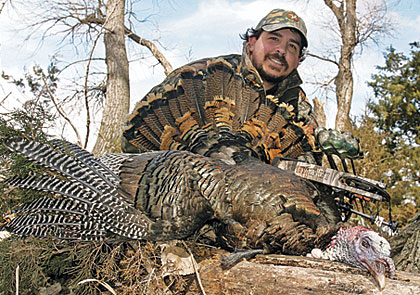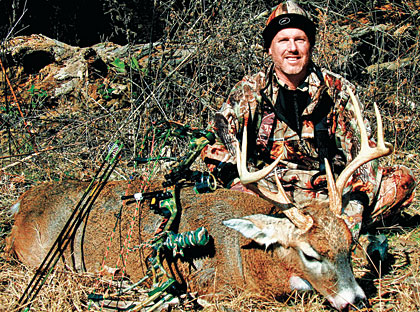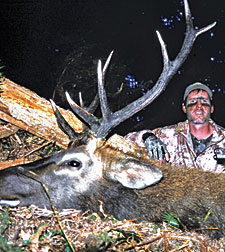December 15, 2010
Today's High-Tech Heads Are Engineered to Fly Accurately and Kill Quickly.
By Patrick Meitin
Pardon the wing-shooting analogy, but choosing the right broadhead is similar to selecting a viable shotshell according to bird size and toughness. Certainly I've killed quail with "duck loads," just as I've killed turkeys with cut-on-contact "elk broadheads." But that doesn't mean either constituted ideal choices. Take a particular broadhead weight -- the currently-popular 100 grain, or still-viable 125 -- and you'll quickly discover a mind-boggling array of designs. This includes mechanical, fixed-blade and cut-on-contact designs, though I further define broadhead performance requirements according to the game at the receiving end of my arrows.
Before we begin, keep in mind the following recommendations assume average bowhunting energy. For most of us, this means compound bows of 60-65 pounds draw weight, pulled to 28-29 inches, shooting a 350-450-grain finished arrow. I'd wager this covers 75 percent of us. Sitting on one extreme or the other of the energy scale, either limited by a short draw length and/or low draw weight or pulling he-man draw weight of more than 70 pounds, changes everything. Adjustments can be made accordingly.
Advertisement
I also tend to think in worst-case scenarios. I like to know if something goes teribly wrong -- an accidental shoulder-blade hit, for instance -- broadhead choice won't spell doom.
Big Holes
Some game simply asks for aggressive, wide-cutting heads. Turkeys come immediately to mind, though I'll include javelina, pronghorn, Coues whitetail and smaller southern whitetail. Slight stature, thin skin and light bones practically guarantee killing penetration even from the most aggressive broadheads.
Advertisement
On the smallest game, wide-cutting heads give you a greater margin of error relative to smaller vitals should your shot go slightly off mark. And, at the risk of eliciting hate mail, wide-cutting broadheads on long-range game such as pronghorn, or smaller whitetail in thick areas where trailing is more difficult, can also turn marginal hits into kills. Let me put it another way: Would you rather gut-shoot a string-jumping whitetail doe with an inch-wide "mini" head, or a 1€‰1„2-inch wide mechanical? I am in no way advocating sloppy shooting; it's just that "stuff" (like string jumping) happens.
As a general rule, "aggressive" points to mechanical designs, though not every mechanical can be rightly termed aggressive, just as not every mechanical design is created equal. Aggressive indicates anything with a 1€‰½-2-inch cutting diameter with flip-back blades and steep cutting angles (there are wider cutters, but they can prove too much of a good thing without sufficient kinetic energy).
Lines blur considerably with more efficient designs (such as Rage), rear deployment giving up less energy during opening. But in general, if you wish to use an aggressive, blood-spilling mechanical, you're best to keep animals small, or shoot a setup that produces above-average kinetic energy.
 Dense feathers and a small vital area make bowhunting turkeys a unique challenge. Wide-cutting expandables measuring 1€‰1„2 inches or more are the perfect broadhead choice for serious turkey hunters. |
Everyman Heads
Roughly 80 percent of us bowhunt little else but whitetail deer. This is a study in anything from a 150-pound doe or mature Southern buck to a 250-pound Midwestern brute.
Others spend their bowhunting days pursuing 150-300-pound mule deer or 100-350-pound black bears. The elevated attack angles of stand hunting, generally sturdier makeup of such animals, and a propensity to cling to life with the tenacity of a desert shrub demand a greater level of reliability and pass-through penetration, plus the ability to spill maximum volumes of trailing blood. That's a lot to ask of a broadhead, and the reason compromises must be made.
It's always a balancing act between cutting diameter and penetration. Increasing penetration normally means sacrificing cutting diameter. We need to drive our broadheads home, but also leave enough blood behind to allow quick recovery in sometimes congested vegetation. The industry seems to have hit on a happy medium of around 1€‰3„16 inches -- give or take a 1„8-inch. A majority of the most popular fixed-blade heads fall into this class. Fixed-blade cutting diameter is also directly related to accuracy and ease in tuning. The 1€‰3„16-inch touchstone also represents a size at which straight flight and tight groups can be easily achieved while shooting "average" equipment setups.
Typically, with "standard" mechanical designs, getting much above 1€‰¼ inches in cutting diameter can mean giving up some degree of penetration. There are decided exceptions in the newest lots though, including efficiently-designed rear-deploying models (Rage SlipCam, Rocket Meat Seeker, Tru-Fire Switchblade and Sanford ExpanDead plunging-tip expandables), those with cutting-tips (Carbon Express F-15 Expandable or Rocket Steelhead XP) and designs sans constricting O-rings and rubber bands (NAP Spitfire and G5's new T3).
 Field Editor Patrick Meitin used New Archery Products' fixed, one-piece HellRazor with a 1€‰1„4-inch cutting diameter to kill this Midwestern bruiser. |
Driving Deeper
When I bowhunt elk or moose, especially when toting my beloved traditional gear (which can't begin to approach the energy produced by even low-poundage compounds) or tackling Africa's dangerous game, I look to heads built solely around deeper penetration. This might come through smaller cutting diameters, which also allows top-notch accuracy from the fastest bows, or through more efficient cutting-tip or true cut-on-contact designs that slide through hide, flesh and bone with minimum resistance.
The "mini" head craze came about while seeking fixed-blade accuracy from the hottest compound models. This was accomplished through abbreviated blade surfaces, the most extreme models not much wider than they are long. There's simply not a lot there to catch on hide or muscle, or lodge in bone. Consequently, most penetrate as well as they fly true. Here, I'm talking of fixed-blade heads with cutting diameters from 1-1€‰1„8 inches (Tru-Fire T1, G5's Striker or Muzzy's MX-4, as examples), most with deeply-faceted tips
that cut well on contact, or mechanicals with like cutting diameters (like Trophy Ridge's Steelhead). Several broadhead manufactures have taken replaceable-blade broadheads to the next level by installing cutting razor inserts into the tips where they start penetration effortlessly (like Carbon Express' Troika ST3).
True knife-blade, cut-on-contact designs are the choice when everything is on the line via dangerous game, when wielding low kinetic energy (traditional or youth/women compounds) or when looking for complete pass-throughs on the largest game. Most can be resharpened by hand, making them cost effective for bowhunters on a budget. Some include single-beveled edges for deeper penetration (Alaska Bowhunting Supply's GrizzlyStik Broadheads), one-piece construction for absolute reliability (G5 Montec or New Archery Product's HellRazor) and bleeder blades for a wound less likely to close up to restrict blood flow (Carbon Express F-15 Dual Blade or Muzzy Phantoms).
 Elk and moose are decidedly different beasts compared to deer-sized game. Penetration is paramount to killing heavy-boned animals. To that end, cut-on-contact broadheads and compact, fixed-blade heads are ideal choices for driving deep into vitals. |
Yet it must be remembered, for everything gained something is sacrificed. Smaller cutting diameters (especially those with simple two-blade designs) can mean less blood left behind after the shot.
However, it also must be pointed out that most mini heads cut holes much larger than measured cutting diameter because of steep blade angles that stretch hide before cutting begins (which also means sacrificing a bit of penetration compared to true cut-on-contact designs).
Broadhead design has always been a hot-button topic, and certainly there will be those who will argue with my guidelines.
Still, I want to be prepared for the worst-case scenario. In a perfect world, every shot would result in a double-lung hit through flimsy ribs and soft tissue. But the right head for the game you're after should maximize performance under the most likely contingencies you'll encounter.
